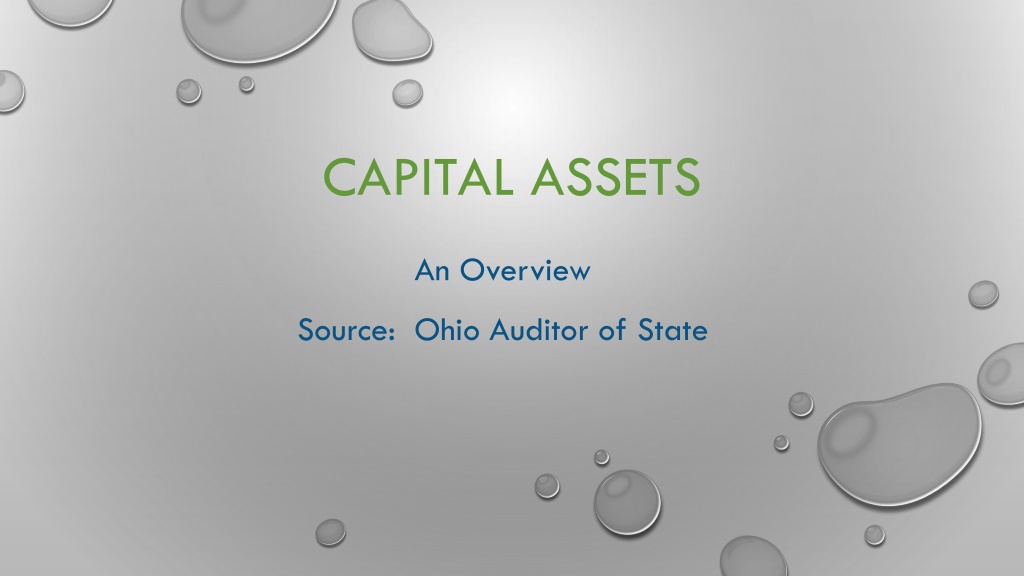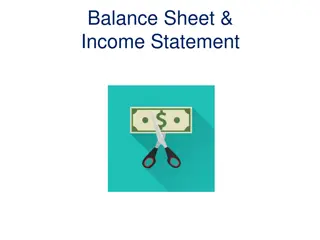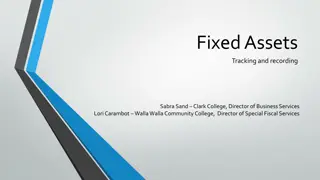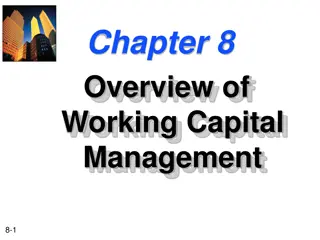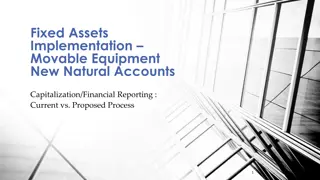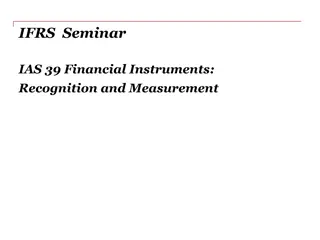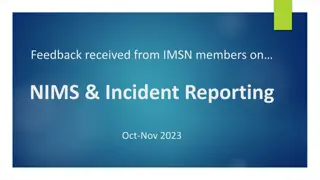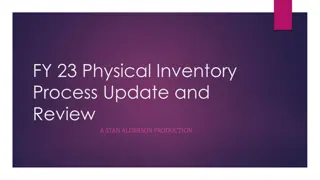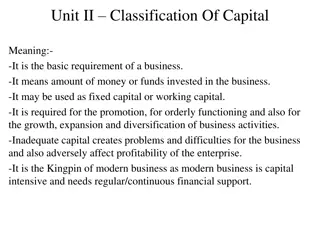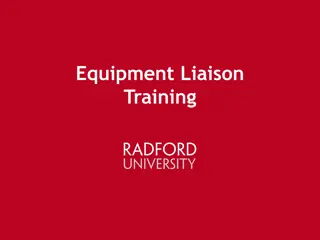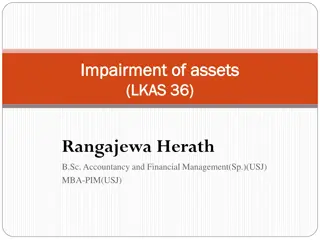Understanding Capital Assets in Financial Reporting
A capital asset is a long-term asset used in operations with a useful life extending beyond a single reporting period, such as land, buildings, and infrastructure. These assets are reported at historical cost, including ancillary charges. Special assets like works of art or historical treasures are considered non-depreciable. Knowing how to value, capitalize, and care for capital assets is crucial for accurate financial reporting.
Download Presentation

Please find below an Image/Link to download the presentation.
The content on the website is provided AS IS for your information and personal use only. It may not be sold, licensed, or shared on other websites without obtaining consent from the author. Download presentation by click this link. If you encounter any issues during the download, it is possible that the publisher has removed the file from their server.
E N D
Presentation Transcript
CAPITAL ASSETS An Overview Source: Ohio Auditor of State
What is a Capital Asset? How do I value an asset? What do I have to capitalize? Depreciation & Useful Life Impaired assets? Unorganized chaos!!! Why do I even care?
DEFINITION OF A CAPITAL ASSET Includes: land, land improvements, easements, buildings, building improvements, works of art & historical treasures, infrastructure, construction in progress, and all other tangible or intangible assets Used in operations Have initial useful life extending beyond a single reporting period GASB 34, paragraph 19
INFRASTRUCTURE Long-lived capital assets Normally stationary, fixed Preserved for significantly greater number of years than most other capital assets Examples: roads, bridges, tunnels, drainage systems, water/sewer systems, lighting systems Note: generally, buildings are NOT considered part of infrastructure
UNUSUAL CAPITAL ASSETS These are most often considered Non-Depreciable assets: Works of Art Historical Treasures
HOW MUCH ARE MY ASSETS WORTH? Capital assets should be reported at historical cost. Cost should include ancillary charges necessary to place the asset into its intended location & condition for use. Ancillary charges include costs that are directly attributable to the asset acquisition. Examples: freight & transportation charges, site prep, professional fees such as architectural & engineering. GASB 34, paragraph 18
HISTORICAL COST How much you paid for the asset. What if you don t know the historical cost (you no longer have payment record)? Estimate historical cost using the Consumer Price Index, which is part of an annual Bulletin from the Auditor of State. For 2019, it is Bulletin 2019-02.
HOW MUCH IS MY DONATED ASSET WORTH? Cost = Acquisition Value at time of acquisition plus ancillary charges, if any. Acquisition Value is: The price that would be paid to acquire an asset with equivalent service potential in an orderly market transaction at the acquisition date, or in the amount at which a liability could be liquidated with the counterparty at the acquisition date is referred to as acquisition value. GASB 72, paragraph 79
DONATED ASSETS CONT. Acquisition Value is the price you would have paid to acquire the same or very similar asset on the acquisition date. Acquisition Value is a market-based entry price & can be calculated from: Manufacturer catalogs Price quotes in periodicals Recent sales of comparable assets Other reliable information Note: professional assistance is not required.
WHAT DO I NEED TO CAPITALIZE? Is there a minimum level for capitalization of assets? No. Different types of assets may have different capitalization thresholds, which is the dollar value above which asset acquisitions are added to capital asset accounts. Qualitative characteristics may also affect capitalization policies. Different thresholds may be established & used for purposes other than financial reporting, for example, for management control or for compliance with laws/regulations. GASB 34, Question 7.9.5
WHAT DO I NEED TO CAPITALIZE? What information should be included? There are no specific requirements for capitalization policies. However, policies may include: Capitalization thresholds Methods used for determining historical cost or acquisition value Extent of infrastructure capitalization probably not applicable to most schools GASB 34, Paragraph 115e, Question 7.85.4
WHAT DO I NEED TO CAPITALIZE? Is title to an asset always equivalent to ownership? Ownership is considered a collection of rights to use & enjoy property, including the right to transmit it to others. For assets held for public benefit, such as roads, the right to use & enjoy property includes right to determine how the property is used. All rights may not be vested in a single entity. Title refers to the right to or ownership of an asset & also refers to the evidence of such ownership. Title may be evidence of legal ownership however, may be held for entity s own benefit or for benefit of another entity. Generally, holding title = ownership. The entity that holds title should report the asset in its own financial statements. Facts & circumstances may vary, as with a capital lease where lessor holds title. GASB 34, Paragraph 115e, Question 7.9.6
WHAT DO I NEED TO CAPITALIZE? Should a capitalization policy be applied only to individual assets or can it be applied to a group of assets acquired together? Example: District has capitalization threshold of $5,000 for equipment. If the district purchases 100 computers costing $1,500 each, should the computers be capitalized together? GASB 34, Paragraph 115e, Question 7.9.8
AND THE ANSWER IS Capitalization policies include many considerations such as finding balance between ensuring all significant capital assets are capitalized and minimizing the cost of record keeping for capital assets. Capitalization policy could require capitalization of certain types of assets whose individual acquisition costs are less than the threshold. Computers, classroom furniture & library books, for example, may not meet the capitalization policy on an individual bases, yet might be considered material collectively. GASB 34, Paragraph 115e, Question 7.9.8
LETS MAKE A DEAL! I purchased land for $1. Am I good or what??? The purchase price of $1 does not meet the definition of an exchange transaction, where each party receives & gives up essentially equal values. The substance of this transaction is that the district received a donation of land (a non-exchange transaction), & the district should report the acquisition at the estimated fair value of the land at the date of the donation. GASB 34, Question 7.12.17
SOFTWARE LICENSES A district acquires commercially available computer software through a 5-year licensing agreement. Under terms, the district will make annual installment payments to the vendor for the right to use the software over the life of the agreement. How should this transaction be reported? GASB 34, Question Z.51.1
ANSWER The district should report the licensed software as an intangible asset. A long-term liability representing obligation to make annual payments should also be reported on GAAP statements. GASB 34, Question Z.51.1
SO MANY ASSETS, SO LITTLE TIME! Each school district s capitalization threshold should be specific to the district. Use of a capitalization threshold is an application of an accounting policy, not a change in accounting principle. Changes in capitalization threshold involve many considerations such as ensuring all significant capital assets are capitalized while considering the cost of record keeping for capital assets. GASB 34, Question 7.22.17
DEPRECIATION & USEFUL LIFE Capital assets should be depreciated over their estimated useful lives unless they are inexhaustible or are infrastructure assets reported using the modified approach. Inexhaustible = land and some land improvements GASB 34, paragraphs 21 & 22
WAIT A SECOND . Are land improvements depreciable? That depends: Improvements that produce permanent benefits are not depreciable. Example: fill, grading costs, certain landscaping Improvements that are considered part of a structure or that deteriorate with use or over time should be considered depreciable. Example: parking lots, fencing GASB 34, Question 7.13.4
DEPRECIATION METHODS Any rational & systematic method may be used. Ohio School Districts use the Straight-line method. GASB 34, Question 7.13.2
SALVAGE VALUES Salvage value is the estimated fair value of a capital asset remaining at the conclusion of its estimated useful life. An asset with an estimated salvage value will, in theory, never be fully depreciated. Infrastructure due to costs of demolition & removal, infrastructure assets generally have no salvage value. Salvage values are not required. GASB 34, Question 7.13.3
HOW LONG WILL THESE THINGS LAST? To determine estimated useful life, consider: Asset s present condition Use of the asset Construction type Maintenance policy How long it is expected to meet service & technology demands For intangible assets, also consider any legal, regulatory or contractual provisions GASB 34, Question 7.14.1
ANY RECOMMENDED SCHEDULE OF USEFUL LIFE? None recommended by Ohio Auditor of State. Schedules of useful lives recommended by professional organizations (accounting firms, appraisal companies, ) may be a helpful starting point. However, schedules of depreciable lives established by federal or state tax regulations are NOT intended to represent useful lives. GASB 34, Question 7.14.2
ARE YOU SURE THERE ISNT A CHEAT SHEET??? Some sources of potential useful lives are: General guidelines from professional or industry organizations Information on comparable assets of other school districts Internal information, such as Board policy GASB 34, Question 7.14.3
FINALLY, IM DONE! NOT SO FAST Is it ever necessary to review the estimated useful life in later years? Yes! A periodic review is necessary for depreciation to reflect allocation of the asset s cost over its useful life. Many factors may affect useful life. For example: The asset will not be replaced (remember Read 180 machines?) Preventative maintenance has not been done. Use of the asset may have changed. The asset has been damaged. GASB 34, Question 7.14.4
WHENSHOULD I REMOVEASSETSFROMMYSYSTEM? Capital assets should be written off when they are disposed of. Districts may have assets in use that are fully depreciated. Those assets should continue to be reported. Fully depreciated capital assets do not affect the net balance of reported capital assets. GASB 34, Question 7.13.5
WEONLYHAVE PART OFANASSETWHATDOWEDO? An asset is impaired if: The decline in service utility of the asset is large in magnitude and The event or change in circumstance is outside the normal life cycle of the asset. GASB 42
EXAMPLESOF IMPAIRED ASSETS Physical Damage from earthquake, tornado, etc. Changes in laws, regulations or other environmental factors Ohio outlaws use of computers! Technological changes or obsolescence example: Commodore 64 computers (anyone still have any of those?) Changes in manner/duration of use example: district abandons a building due to structural issues. Construction stoppage district begins digging & pouring a foundation for a new building only to discover a hidden diamond mine! 1 1 1 GASB 42
MYASSETSAREAMESS! NOWWHAT? It may be time to get a new appraisal! Before contracting with an appraisal company, sit down with them & go over everything up front, especially if there are staff personal items that will not be included. Make sure you explain all types of items that will not be included. Do NOT let the company dictate useful lives, historical costs, category codes, locations, etc. Make sure you agree with their plan, especially for larger items (land, buildings, buses, etc.) Talk with your auditors about how to account for significant changes in value. Giving them a heads-up & listening to their suggestions will save you time (& headaches!) on your next audit.
WHATAREMYAUDITORS REALLY LOOKINGFOR? Are your assets complete? Have you accounted for everything you should? Are assets posted to correct asset class & function? Are you following your Board s Fixed Assets Policy? Does the Board policy & useful lives assigned appear reasonable? Is depreciation being calculated correctly? Note: Every audit firm or audit team and every audit year can be different! Each auditor will look for different things, while they are also required to look at certain things which may not have been required in prior years.
WHYAREYOUALLTORTURINGUS? ISALLOFTHISREALLYNECESSARY? GAAP answer: The purpose of reporting capital assets, including CIP & infrastructure, is to contribute to information about the consumption of all resources used in providing services in the current period & about the net economic resources remaining that can be used to provide services in the future. Non-GAAP answer: It is used as a planning tool a way to keep track of how long the things you purchase are lasting &, based on those life spans, it allows you to prepare financially for their replacement.
SOURCES Governmental Accounting Standards Board (GASB) GASB Statement number 34 GASB Statement number 72 GASB Implementation Guide chapters 7 and z Auditor of State Bulletins https://ohioauditor.gov/publications/bulletins/2019/default.html Other https://www.gfoa.org/best-practices 20+ years of providing assistance to school districts!
GOOD NEWS!!! From time to time, ODE reviews existing EMIS reporting elements to determine if there is a continued business case for collecting specific data (State & Federal requirements, frequently requested data, compelling public policy value, etc.). Over the last few months, they reviewed the Capital Asset Reporting (QC) in EMIS. Based on their conversations with the Auditor of State s Office, the Ohio Facilities Construction Commission, & a handful of OASBO members, ODE determined there is no need for the EMIS reporting. In other words, nobody upstream was using the data for any purpose! Districts will still be required to keep a capital asset inventory & report the value in their financial statements, but they will no longer need to report this on the EMIS Data Collector! ODE EMIS Changes 20-91
WHATDOESTHAT MEAN? No change in recording Acquisitions & Disposals. Only change in EIS Fiscal Year End process: no running EISEMS or submission to Data Collector. EISCD will no longer include EISEMS. No change to reports provided to GAAP accountants. Timing for closing EIS FYE will be driven by Audit and/or GAAP Accountant schedules.
